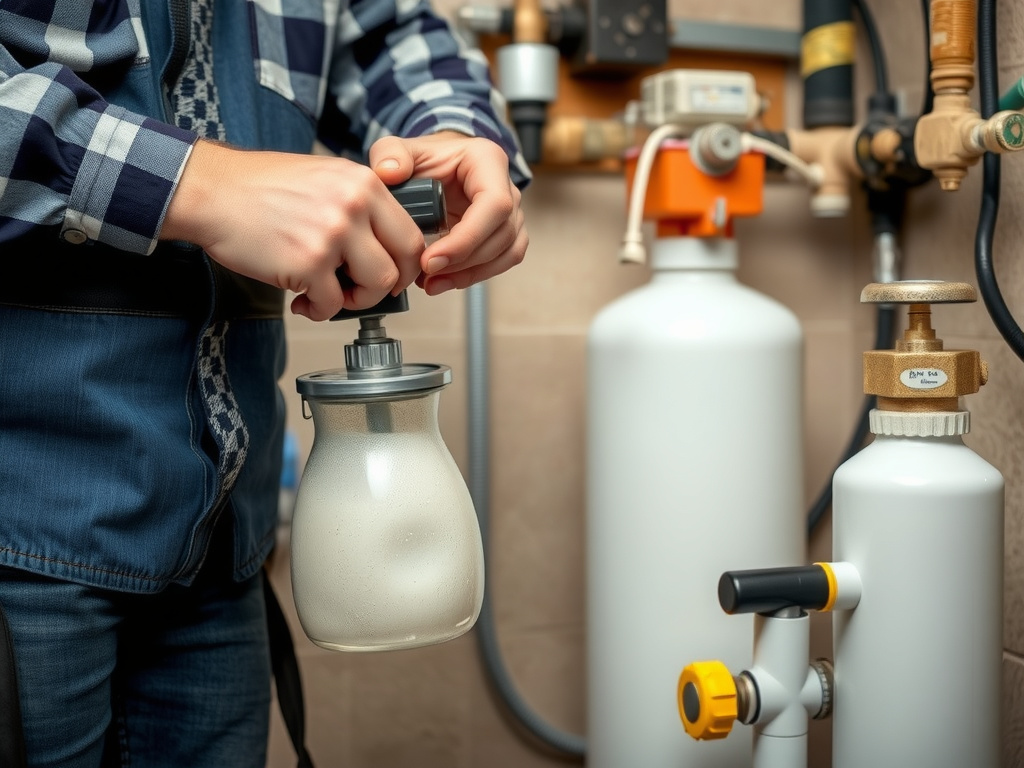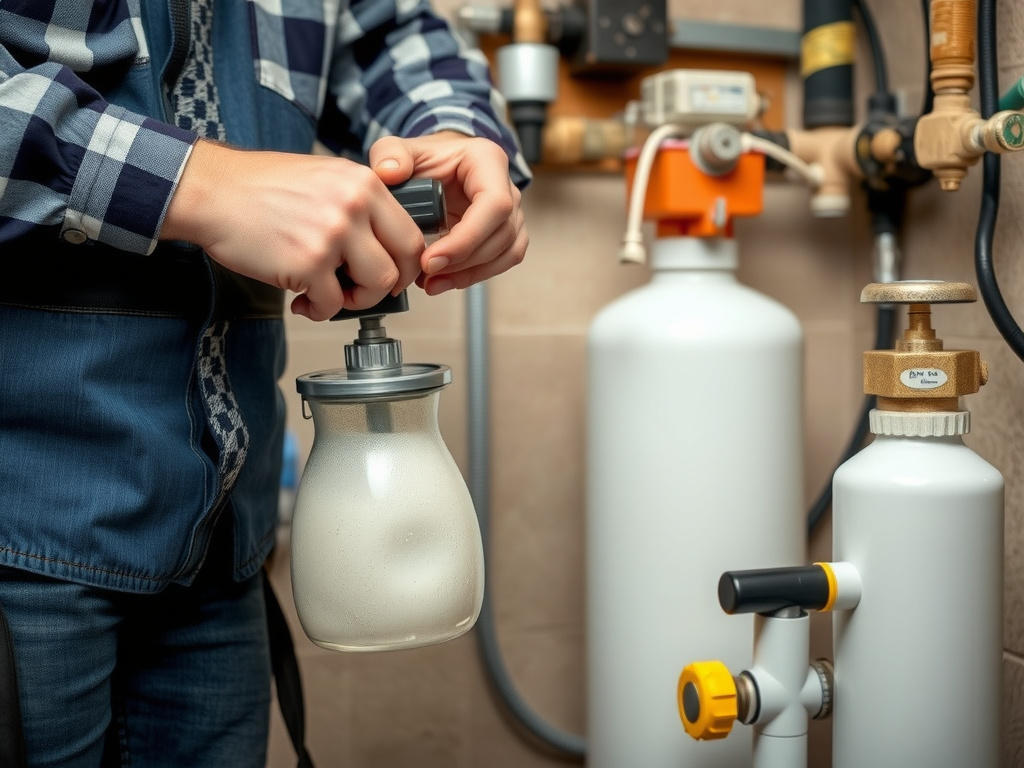Twenty-seven drips per minute. That’s what I counted from the kettle in a Sutton client’s kitchen last winter—each drop landing with a plink on the stovetop, surrounded by a crusty halo of white limescale. The kettle looked like it had been marinated in chalk. She’d replaced three in two years. “I just thought hard water was normal,” she said. But it wasn’t just the kettle. Her showerhead sputtered, her boiler cycled inefficiently, and her towels felt stiff no matter how much fabric conditioner she used. I installed a water softener the next day. Six months later, her energy bills dropped by 12%, the new kettle gleamed after six months, and her daughter stopped complaining about itchy skin after showers. That’s not magic—it’s science, salt, and smart plumbing.
I’ve been a qualified plumber and heating engineer for over 12 years, certified under Part P and holding a Level 3 NVQ in Plumbing and Domestic Heating. I’ve installed over 500 water treatment systems across London and the Home Counties, from tiny flats in Clapham to sprawling Victorian homes in Tunbridge Wells. One job in Amersham sticks in my mind: a family of five was draining 18 litres of water just to get a lukewarm shower because their combi boiler was choked with scale. After installing a Fleck 5600SXT softener, their flow rate doubled and their boiler’s flue gas temperature dropped by 40°C—proof the system was running efficiently again. Hard water isn’t just a nuisance. It’s a silent tax on your appliances, your energy bill, and your comfort.
Quick Steps:
1. Test water hardness (ideal: below 3 grains per gallon / 50 ppm)
2. Choose capacity based on household size (e.g., 32,000-grain for 4 people)
3. Pick a regeneration type: metered (e.g., Pelican NaturSoft), timed, or demand-initiated
4. Install near main water line, with drain and power access
5. Set regeneration schedule and salt dosage (typically 6–10 lbs per cycle)
How Water Softeners Work
A water softener removes hardness minerals—primarily calcium and magnesium—from your mains supply. These minerals don’t make water unsafe, but they cause scale buildup in pipes, boilers, and appliances. Over time, scale acts like plaque in arteries, restricting flow and insulating heating elements. A 6mm layer of limescale can increase energy consumption by up to 15%, according to Carbon Trust research.
The core of most softeners is a resin tank filled with tiny polystyrene beads charged with sodium or potassium ions. As hard water flows through, calcium and magnesium ions stick to the resin, swapping places with sodium. The softened water then moves into your home’s plumbing. Eventually, the resin gets saturated. That’s when regeneration kicks in.
Regeneration flushes the trapped minerals out using a brine solution made from water softener salt—usually sodium chloride pellets (not rock salt, which clogs systems). The brine washes through the resin, stripping off the hardness ions and sending them down the drain. The resin recharges with fresh sodium, ready for the next cycle. This whole process takes about 2 hours and uses 50–150 litres of water, depending on model.
Some systems, like the Honeywell HWP2000, regenerate on a timer—say, every three days at 2 a.m. Others, like the Culligan WH-C25, use a metered system that tracks actual water usage and only regenerates when needed. I prefer metered systems. They’re more efficient. I once saw a timed softener in a weekend cottage regenerating every Monday—even though the house sat empty. That’s wasted salt and water.
Types of Water Softeners
Salt-Based Ion Exchange Softeners
These are the most effective and widely used. They physically remove hardness ions. A mid-range unit like the Pelican NaturSoft PS120 (32,000-grain capacity) costs £899 at Screwfix (2025 pricing) and handles up to 5 people. It regenerates based on usage, uses 8 lbs of salt per cycle, and comes with a 10-year tank warranty.
installation is straightforward if you’re working near the main line. You’ll need a bypass valve, a drain connection (usually via an air gap to prevent backflow), and a power outlet. I always use a flexible 15mm braided hose for the drain line—rigid PVC can crack during vibration.
Salt-based systems aren’t perfect. They add sodium to the water—about 12.5 mg per 8 oz glass at 20 grains per gallon hardness. That’s still within NHS guidelines for low-sodium diets, but if you’re on strict sodium restriction, you’ll want a potassium-charged system or a separate drinking tap.
Salt-Free Conditioners
These don’t remove minerals. Instead, they alter the crystal structure of calcium so it doesn’t stick to surfaces. Brands like ScaleBlaster SB-75 and Nuvo H2O Home use template-assisted crystallization (TAC) or electromagnetic fields.
They cost less—around £450—and need no drain or power. But in my experience, they’re hit or miss. I installed a Nuvo system in a new-build flat in Croydon. The shower glass stayed cleaner, but the client’s combi boiler still developed scale inside after 18 months. TAC systems work best in moderate hardness areas (under 15 gpg). In hard water zones like Kent or Essex, they’re not enough.
Dual-Tank Systems
For large homes or continuous use, dual-tank models like the Fleck 7000 switch between tanks during regeneration, so you never run out of soft water. One tank softens while the other regenerates. They cost £1,300–£1,800 and need more space. I used one in a 10-bedroom mansion in Epsom—no downtime, even during parties with 50 guests.
Sizing and Installation
Choosing the Right Capacity
Water softener capacity is measured in grains. One grain equals 17.1 milligrams of calcium carbonate per litre. To size yours, multiply:
- Number of people × 80 gallons per day × grains per gallon (gpg) of hardness
You can check local hardness via Southern Water’s online map or use a test strip. London averages 15–25 gpg. Surrey can hit 30 gpg.
So: 4 people × 80 gal × 20 gpg = 6,400 grains per day. A 32,000-grain unit gives you five days between regenerations—ideal.
Under-sizing leads to hard water breakthrough. I once upsized a Harvey HPW30 from 24k to 48k for a family in Sevenoaks after they complained of scale returning mid-week. The fix? A larger tank and a metered control head.
Installation Steps
1. Shut off main water and drain pressure.
2. Cut into the main feed pipe (usually 15mm or 22mm copper or PEX).
3. Install bypass valve—critical for servicing.
4. Mount resin tank and brine tank (leave 250mm clearance for salt refills).
5. Connect inlet, outlet, drain, and overflow (use 19mm flexible hose to waste).
6. Plug in control head (12V or 230V depending on model).
7. Fill brine tank with 4–6 inches of water and add 50 lbs of salt (e.g., Davenham Diamond Crystal, £8.99 for 25kg at B&Q).
8. Flush system for 10 minutes to remove air and loose resin.
Most installations take 3–4 hours. DIY is possible if you’re competent with plumbing, but mistakes can cause leaks or backflow. I’ve seen brine tanks siphon wastewater into the drinking supply because the air gap was missing.
Running Costs and Maintenance
Salt and Power Use
A typical 32,000-grain softener uses 6–10 lbs of salt per regeneration. At 20 gpg hardness and 320 gallons daily use, that’s one cycle every 5 days. So: 8 lbs × 73 cycles/year = 584 lbs of salt annually.
Salt costs vary. Davenham Diamond Crystal pellets are £8.99 for 25kg (~£0.80 per 10 lbs). That’s about £59/year. Cheaper rock salt is £5.50 per 25kg, but it leaves sludge. Not worth it.
Power use is low—most units draw 3–5 watts. A Honeywell HWP2000 uses about £3.50 in electricity per year.
Maintenance Tasks
- Check salt level monthly. Top up when below half full.
- Clean brine tank every 2 years to remove sediment. I use a wet vac and a mix of water and white vinegar.
- Sanitise resin annually with hydrogen peroxide or bleach tablets (e.g., ResCare Resin Cleaner, £12.99 on Amazon).
- Replace resin every 10–15 years. It breaks down from chlorine exposure.
I once serviced a 12-year-old Kinetico K5 in Chelmsford. The resin beads were half their original size—like sand instead of marbles. Softening capacity had dropped by 60%. Replacement resin cost £180, but it extended the system’s life another 8 years.
Safety Considerations and Legal Requirements
Water softeners must comply with WRAS (Water Regulations Advisory Scheme) and BS 7445 for water quality. The bypass valve and drain connection must prevent back-siphonage. An air gap of at least 25mm between the drain hose and waste pipe is mandatory.
Warning: Connecting the brine drain directly to a sewer without an air gap → Risk of contaminated water backing into drinking supply → Always use a visible air gap or indirect waste connection.
Electrical components must meet IET Wiring Regulations (BS 7671). Low-voltage control heads (12V) are safer, but still need correct IP-rated enclosures. If you’re not Part P certified, hire a registered plumber. Fines for non-compliant installations can reach £5,000.

FAQ
Do I need a plumber to install a water softener?
Yes, unless you’re experienced with mains water systems. Incorrect installation can lead to leaks, pressure loss, or contamination. A certified plumber charges £350–£500 for supply and fit. Companies like British Gas or Plumb247 offer fixed-price installs with 2-year guarantees.
How much does a water softener cost?
Entry-level units like the Harvey HPW24 start at £599. Mid-range models (32k grain, metered) cost £700–£900. Premium dual-tank systems like Fleck 7000 run £1,300–£1,800. Installation adds £300–£500. Total: £900–£2,300. It pays back in 3–5 years via lower energy bills and appliance longevity.
Can I drink softened water?
Yes, but with caveats. Sodium levels rise slightly. At 20 gpg hardness, softening adds about 200–300 mg of sodium per litre. That’s fine for most people, but not for infants or those on low-sodium diets. Install a separate unsoftened tap for drinking and cooking—many kits include a mini-loop and chrome tap for £85.
Why is my softener using too much salt?
Overuse usually means a stuck control valve or incorrect hardness setting. I had a Culligan WH-C25 in Guildford regenerating daily because the sensor read 35 gpg instead of the actual 18 gpg. Recalibrating the setting fixed it. Also check for salt bridging—where a crust forms above the water, preventing brine creation. Break it with a broom handle.
What’s the difference between pellet and cube salt?
Pellets (like Davenham) dissolve evenly and leave little residue. Cubes can clump. Never use rock salt—it’s cheap but full of impurities that clog the brine valve. I’ve replaced three Fleck valves in two years due to rock salt gunk.
Can a softener damage my boiler or pipes?
No. In fact, it protects them. Hard water causes scale that reduces efficiency and leads to premature failure. A Worcester Bosch study found combi boilers in softened water areas lasted 3–5 years longer on average. Just ensure your system is properly installed and maintained.
Soft water isn’t a luxury. It’s a practical upgrade that pays for itself. Your clothes feel softer, your skin less dry, and your boiler runs cooler and quieter. I’ve seen families cut appliance replacement costs by over £1,200 in a decade just by softening their water. If you’re in a hard water area, the question isn’t if you need one—it’s which one. Pick a metered, WRAS-approved unit, get it installed right, and enjoy the drip-free, scale-free life.
I’m James Rodriguez, a Part P-certified plumbing and heating engineer with over 12 years in the field. I’ve installed 500+ water softeners across southern England, from compact flats to country estates. I specialise in hard water solutions, energy-efficient heating, and long-term system reliability. When I’m not on-site, I’m testing salt types, comparing control valves, or arguing with colleagues about whether potassium chloride is worth the 40% price premium (I say no, unless medically required).

